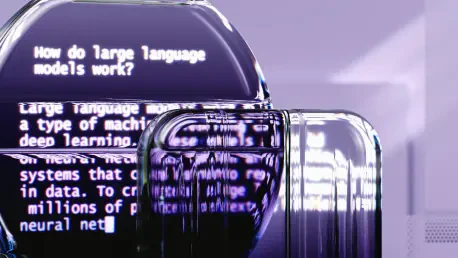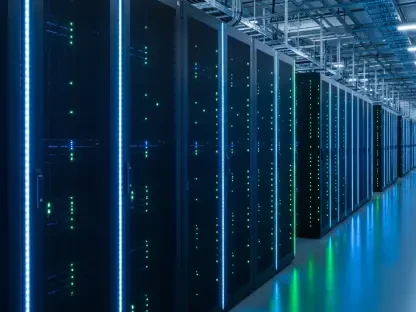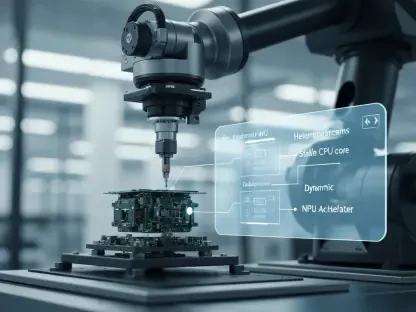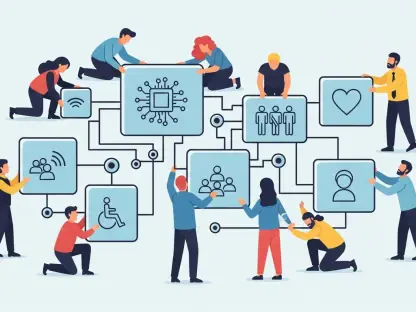Setting the Stage: A New Era in AI Competition
Imagine a world where artificial intelligence can solve complex problems with near-human precision, streamline intricate coding tasks, and adapt seamlessly across industries—all within a single platform. This is the reality OpenAI has ushered in with the launch of GPT-5, a large language model that redefines the boundaries of AI capability. As the tech landscape grows increasingly competitive, this release marks a critical juncture for market players and end-users alike. The purpose of this analysis is to dissect the market trends, competitive dynamics, and future projections surrounding GPT-5, shedding light on its transformative potential. By exploring its implications for various sectors, this examination aims to provide a clear perspective on how this innovation could reshape the AI industry and influence strategic decision-making.
Diving Deep: Market Trends and Competitive Analysis
Technological Leap: GPT-5’s Core Advancements
The arrival of GPT-5 signals a significant shift in the AI market, characterized by enhanced reasoning and problem-solving capabilities that outstrip previous models. OpenAI has engineered this model to tackle multi-step tasks with remarkable accuracy, addressing long-standing issues like contextual drift and unreliable outputs. This improvement is poised to impact sectors such as scientific research and legal analysis, where precision is non-negotiable. Market data suggests a growing demand for AI tools that minimize errors, with adoption rates in professional services projected to rise by 30% over the next two years from 2025 to 2027.
Beyond error reduction, the model’s versatility across text, image, and audio interactions positions it as a leader in multimodal AI solutions. This adaptability caters to diverse user needs, from educational platforms to entertainment applications, broadening its market appeal. Industry analysts note that such features align with a rising consumer expectation for integrated, user-friendly technologies, potentially driving significant market share for OpenAI if leveraged effectively.
Developer Ecosystem: Coding Capabilities Reshaping Tech
A key market trend amplified by GPT-5 is the acceleration of AI adoption within the software development sector. With superior coding prowess, this model sets new benchmarks by outperforming specialized predecessors and integrating seamlessly with agentic tools like Cursor and Copilot. This capability is expected to boost productivity in tech industries, where rapid digital transformation is a priority. Projections indicate that AI-assisted coding tools could capture a market value of over $10 billion by 2027, with GPT-5 at the forefront of this growth.
However, this trend also introduces challenges, such as the risk of over-reliance on AI among novice developers, potentially stunting skill development. Competitive analysis reveals that rivals are not far behind, with other models solving a substantial percentage of programming challenges. OpenAI’s edge lies in its fine-tuned integration and performance metrics, but sustaining this lead will require continuous innovation and developer support initiatives to maintain market dominance.
Accessibility and Customization: Expanding Market Reach
Another pivotal trend is OpenAI’s strategic rollout of GPT-5, designed to maximize accessibility across user tiers, including free, premium, and enterprise segments. By introducing a lighter version for free users upon reaching usage limits, the company balances resource allocation with widespread adoption. This tiered approach taps into a growing market segment of casual users while retaining high-value clients, a strategy that could enhance customer retention rates by an estimated 15% over the coming years.
Customization tools further amplify GPT-5’s market penetration by allowing tailoring for specific industries, addressing niche demands in sectors like healthcare and logistics. This flexibility responds to a market need for personalized AI solutions, with surveys indicating that over 60% of businesses prioritize adaptable technologies. While regional variations in language processing pose minor hurdles, the overall impact is a stronger foothold in global markets, setting OpenAI apart from competitors with less customizable offerings.
Future Outlook: Predictions and Industry Shifts
Competitive Race: Navigating a Crowded AI Arena
Looking ahead, the AI market is set for intensified competition as major players vie for technological supremacy. The timing of GPT-5’s release, closely following updates from rival models, underscores an industry-wide push toward rapid innovation. Market forecasts suggest that the AI sector could grow to a valuation of $500 billion by 2027, driven by advancements in reasoning and task execution. OpenAI’s ability to maintain a lead will hinge on delivering cutting-edge features that resonate with user needs, amidst pressure from tech giants with expansive distribution networks.
Regulatory landscapes also loom large on the horizon, with potential policies around data privacy and AI ethics likely to shape deployment strategies. Analysts predict that compliance costs could rise by 20% in regulated markets, challenging smaller players while favoring established firms like OpenAI with robust infrastructures. Navigating these dynamics will be crucial for sustaining growth and market relevance in an increasingly scrutinized industry.
Sectoral Transformation: AI’s Agentic Future
A forward-looking trend is the rise of agentic AI systems—models that autonomously execute tasks—potentially revolutionizing industries like healthcare, where automated diagnostics could save billions annually. GPT-5’s enhanced capabilities lay the groundwork for such applications, with early adoption in scientific workflows already showing promise. Market projections estimate that agentic AI could account for 25% of enterprise AI investments by 2027, highlighting a shift toward automation and efficiency.
This transformation, however, brings complexities, including workforce displacement concerns and the need for upskilling. Industries adopting these technologies will need to balance innovation with ethical considerations, a factor that could influence market acceptance. OpenAI’s role in driving this trend positions it as a catalyst for change, provided it addresses societal impacts alongside technological breakthroughs.
Reflecting on the Journey: Strategic Insights for the Future
Looking back, the analysis of GPT-5’s market impact revealed a landscape transformed by unparalleled advancements in reasoning, coding, and multimodal functionality. The competitive dynamics underscored a relentless race for innovation, while accessibility strategies broadened user engagement across diverse segments. Sectoral projections pointed to profound shifts, particularly with the advent of agentic systems poised to redefine operational norms. Moving forward, businesses and stakeholders should prioritize integrating such AI tools with human oversight to mitigate risks of over-dependence, while investing in training programs to bridge knowledge gaps. Policymakers, on the other hand, are encouraged to craft balanced regulations that foster innovation without compromising ethical standards. As the industry evolves, the strategic focus shifts toward harnessing these capabilities to address emerging challenges, ensuring that the potential of models like GPT-5 translates into sustainable, impactful outcomes across global markets.









